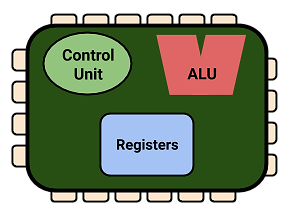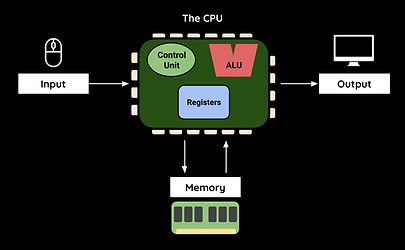Exam Board:
OCR
1.1a: The CPU & The FDE Cycle
Specification:
A-Level 2015
The Central Processing Unit (CPU) is the most important component in any computer system.
The purpose of the CPU is to process data and instructions by constantly repeating the fetch - decode - execute cycle.
CPU Components
The control unit directs the flow of data and information into the CPU.
It also controls the other parts of the CPU.
ALU stands for ‘Arithmetic and Logic Unit’.
It performs simple calculations and logical operations.
.png)
The registers are temporary storage spaces for data and instructions inside the CPU.
The registers are used during the FDE cycle.
Five essential registers are explained below.
Important Registers
A register is a small storage space for temporary data in the CPU.
Each register has a specific role. There are five essential registers used in the FDE cycle:
Program Counter (PC)
A register that tracks the RAM address of the next instruction to be fetched.
Memory Address Register (MAR)
A register that tracks the RAM address of data that is currently being accessed.
Memory Data Register (MDR)
The MDR stores the data that is transferred from RAM to the CPU.
Current Instruction Register (CIR)
A register that stores the instruction that has been fetched from RAM, and is about to be decoded or executed.
Accumulator (ACC)
The ACC stores the result of executions performed in the FDE cycle.
The FDE Cycle
The essential idea of the FDE cycle is that instructions are fetched from RAM, to be decoded (understood) and executed (processed) by the CPU.
The Fetch - Decode - Execute (FDE) cycle is performed by the CPU millions of times every second.
This cycle is how the CPU processes data and instructions for each program or service that requires its attention.
1.
2.
3.
The Program Counter (PC) register displays the address in RAM of the next instruction to be processed.
This value is copied into the Memory Address Register (MAR).
0054
The PC register is increased by 1.
This prepares the CPU for the next instruction to be fetched.
0055
The CPU checks the address in RAM which matches the address held in the MAR.
.png)
0054
4.
The instruction in RAM is transferred to the Memory Data Register (MDR).
.png)
MDR
5.
The instruction in the MDR is copied into the Current Instruction Register (CIR).
MDR
CIR
6.
The instruction in the CIR is decoded (understood) and executed (processed).
Any result of an execution is stored in the Accumulator (ACC) register.
CIR
ACC
7.
The cycle repeats by returning to the first step and checking the program counter for the address of the next instruction.
Buses
Data is transferred within a computer system along pathways called buses.
There are three types of bus:
Address Bus
Sends a memory address of where data is stored. The address is sent from the CPU to RAM in the FDE cycle.
Data Bus
Transfers data between components. Data is sent both ways.
Control Bus
Sends control signals from the control unit to other components of the system. Status signals are sent back to the CPU.
Think about which buses would be used during the FDE cycle and when.
For example, look back at stages 3 and 4 of the FDE cycle above.
-
The address bus is used to send the address in RAM of the next instruction.
-
The control bus is used to send the fetch signal.
-
The data bus is used to transfer the instruction from RAM to the MDR.
Computer Architecture
The way a computer is designed and internally organised is known as its architecture.
The most common type of computer architecture is Von Neumann architecture.
Von Neumann Architecture

The key features of Von Neumann architecture include:
-
The CPU, which constantly performs the FDE cycle, and contains:
-
One control unit
-
One ALU
-
Special registers
-
-
Data and instructions are stored in the same format in the same area in memory. Instructions are commands and data are the specific values used when processing.
-
Data and instructions are transferred across buses (pathways) between the CPU, memory and input or output devices.
Harvard Architecture
The key features of Harvard architecture include:
-
The CPU, which constantly performs the FDE cycle, and contains:
-
One control unit
-
One ALU
-
-
Data and instructions are stored in separate areas in memory. Instructions are commands and data are the specific values used when processing.
-
Data and instructions are transferred across buses (pathways) between the CPU, data memory, instruction memory and input or output devices.

Questo's Questions
1.1a - The Central Processing Unit (CPU):
1a. What does 'CPU' stand for? [1]
1b. What is the purpose of the CPU? [2]
2a. Draw a diagram of the CPU, use the same symbols as shown on this page. [4]
2b. Label the three main components of the CPU. [4]
3. Describe the purpose of:
-
a. The Control Unit [2]
-
b. The ALU [2]
-
c. The registers [2]
4a. Describe the key features of Von Neumann architecture. [3]
4b. Describe the differences between the two main types of architecture. [2]
This page is still being updated.